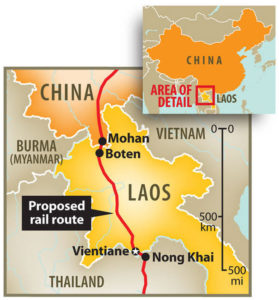The Laotian Times provides a concise, easy-to-read summary of the Laos-China Railway:
Total length: 414.332 kilometers (over 62 percent consists of bridges and tunnels: 258.5 km – due to mountainous terrain)
Number of total stations: 32 stations along the route
Train Track Specs: single 1.435-metre standard-gauge track electrified mixed-traffic line is to be built to China’s GB Grade 1 standards, suitable for 160-200 km/h passenger and 120 km/h freight trains
Construction Began in: in Luang Prabang on December 25, 2016
Project completion: scheduled for five years (by end of 2021)
Cost of Railway: approximately $5.8 billion; 70 percent of which comes from Chinese investment and 30 percent from the Lao side
ICT Cost of Railway: over $3.67 million; Laos-China Railway Company, Lao Telecom, Lao Asia-Pacific and Huawei are to provide internet and mobile phone services from the Mohan-Boten border gate in northern Laos to Vientiane Capital
Lao Government Guidelines: contractors have been asked to employ Lao technicians and companies and use materials available locally in construction; construction must be of a high standard and completed as scheduled; safety must be guaranteed, must comply with Lao laws, respect local customs and culture and not to impact adversely on villagers; environmental protection is a top priority as well
Benefits for Laos: reduce transport costs, increase people-to-people visits, enhance trade and promote cultural exchanges
Expected Number of Passengers: domestic rail passengers should initially reach 3.98 million per year, according to a study by Lao authorities, and could reach up to 8.62 million passengers per year in the future
Regional Significance: part of the Kunming-Singapore regional railway (covering a total distance of approx. 3,000km) and China’s “One Belt, One Road” initiative; will turn Laos from a landlocked country into one that is land-linked
Current State of Railroads in Laos: the only railway in Laos, at present, is a short metre-gauge branch of the Thai network which crosses the River Mekong from Nong Khai to reach a railhead at Thanaleng




